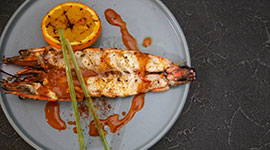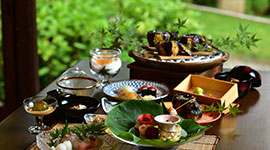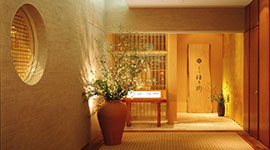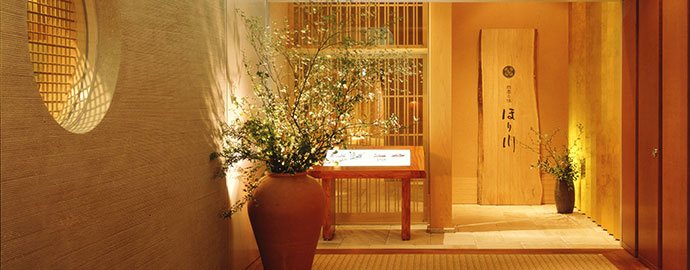
-Carrying on the Spirit-
The Originator of California Roll
Exlusive interview with Hiroshi Horikawa President, Fukusuke Corporation
Q: Please tell us about your company’s roots.
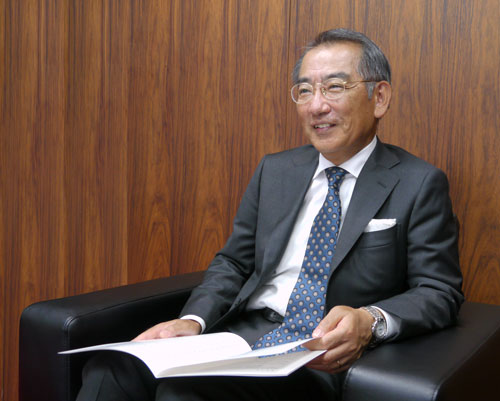
My grandfather Kenji (father of the founder Yasuo Horikawa) founded Tsukuken Shoten, a fresh fish wholesaler, in 1916. Before the war, the company flourished as a high-end specialist
fish wholesaler, mainly handling tai (sea bream) in the districts between Nihonbashi and Tsukiji. After that, Yasuo also joined Tsukuken Shoten. In 1960, the manager of Fukusuke, a sushi restaurant, asked him “I’m thinking of quitting this restaurant, but Tsukuken handles fish, and I can trust you, so would you please take over from me?” That request was the trigger.
That restaurant was located in Ginza 2-chome. After hearing this request, it took Yasuo only 24 hours to make up his mind, choosing to remodel the restaurant and open it as "Uogashi Chokuei Fukusuke", serving a la carte fisx dishes as well as sushi. That became the first Fukusuke restaurant in May 1960. Tsukuken Shoten still operates as a long-established fresh fi sh wholesaler, even now that the market has relocated to Toyosu.
Q: After your first restaurant in 1960, you opened a succession of restaurants in hotels from 1963. What led you to make hotels into your business partners?
We got into expanding our business in hotels because an executive of Tokyo Hilton Hotel back then took a liking to our fi rst restaurant and went there often. Fukusuke’s reputation for taste
and service at Hilton Hotel spread in a fl ash, and we were then able to expand to the Hotel New Otani and Hotel Okura. Other than the Hotel New Otani, we currently have restaurants in the Odakyu Century Southern Tower in Shinjuku, and the Hotel Metropolitan in Ikebukuro.
Q: Back then, what did you take the most care over when developing your restaurant?
Other than honest and transparent billing, we aimed to make restaurants that would be praised for the variety and freshness of fish cuts, made possible by direct management
by Uogashi, and for the excellent attitude of hospitality among the staff.
"Equality in service". Whether our customers are newcomers or regulars, they all come to Fukusuke to eat sushi. Our motto is our spirit of always valuing the customer, so we must not discriminate between them under any circumstances. Thoroughly applying that principle is still the most important thing in our management today.
Q: In 1971 you managed to expand to America. What kind of restaurant did you open? And how did Americans look at Japanese food at that time?
On the advice of the president of a major construction company, Yasuo started thinking seriously about opening a restaurant in America. He had just entered his 40s. Before
opening the restaurant, Yasuo went all over America, studying it closely. He noticed that even if a restaurant called itself "Japanese cuisine", it was not the real thing, and that the idea of "just taking Japanese cuisine and serving it there" involved almost no consideration of Americans' preferences. The fi rst restaurant, in Los Angeles, was a huge 1,300m2.
The first thing inside the entrance was a cocktail lounge. Going further inside, there was a sushi bar, a steak room alongside it, a dinner room further back, and a banquet room past that.
Yasuo modeled after the American style,so customers started by stimulating their appetites at the bar before their meal, andpicked up sushi while eating steak, or enjoyed a full-course meal of real Japanesecuisine. Americans could freely choose how to enjoy their meal, in an environmentthey were familiar and comfortable with, so the layout was really designed to match Americans' tastes.
At that time, Americans who ate meat all the time were being told in the Health White Paper to "eat fi sh, because it's bad for your health to carry on eating just meat". That was one factor behind a sushi boom, and the restaurant became very busy, as it was visited by people from all over the country. After that, we opened our second restaurant (1,000m2) at Santa Ana in 1974. We closed our American restaurants in 1996, but we were operating restaurants there for 26 years. Over that period, Yasuo went back and forth between Japan and America over 200 times.
Q: Is it true that the California roll was thought up by Restaurant Horikawa?
These days, sushi is known all around the world, but when we opened there (1971), Americans still had the strongly ingrained idea that "raw fish is
smelly". At fi rst, the 22-seat sushi counter, which was the centerpiece of the restaurant, did not fill up as we would have liked. So Yasuo thought of a new kind of roll sushi with local avocado and king crab as the fi llers. The nori (dried laver seaweed) was rolled on the inside, where it’s hidden, not on the outside, for the sake of the appearance. He also considered the fl avor aspect, making sure the fragrance of the nori would not obliterate the delicate taste of the avocado. When we reverseimported California rolls into Japan in 1976, some of the sushi cooks resisted, saying “What? Fruit in sushi?", and we had to talk them round, but what we served in our main Fukusuke branch in Tokyo's Ginza district was the debut of California rolls inJapan.
Q: People say it's not easy to educate employees in the world of sushi and Japanese cuisine. What do you think is the most important thing?
Japan is short of craftspeople in general, not just in cooking. You can say that about any business type. In customer service, there are many words and actions to memorize, and it’s not something you can learn in a day. The old approach of mimicry doesn't work any more, and of course, it doesn't go as described in the manual. There are always going to be differences between people, so all you can do is spend time on it.
It's important for people to be personally interested in food, and to know the joy of eating. Of course, there is an undeniable shortage of people, but rather
than pushing too hard to increase our workforce, we strive to value the people who are with us now, and those who will join us later, and make a workplace where each individual can work with enthusiasm.
There's no point lowering quality standards to increase the workforce. People first become craftspeople once they maintain high quality.
Q: What kinds of food experiences do you want overseas customers to have at Fukusuke Horikawa?
“Washoku” was designated as world intangible cultural heritage in 2013, and the Tokyo Olympics and Paralympics will take place in 2020. As restaurants
specializing in sushi, Japanese cuisine, tempura, and teppanyaki, which are the representatives of Japan’s culinary culture, we will strive to deliver highquality performance. Other than fl avor, of course, the real charm of washoku is also in beautiful presentation and the selection of tableware. We want customers to enjoy washoku to the full, with all their senses, and to learn that it is not a stiffl y formal thing, but rather, something to relax and enjoy.
Q: Tell us about the "omotenashi" (hospitality) at Fukusuke Horikawa.
The customers who come to our restaurants aren't just there to fi ll their stomachs. Most of them come with some particular motivation, such as a special occasion or event. We see the greatest hospitality as being about creating restaurants that meet that kind of customer expectation, to enjoy conversation in a relaxed atmosphere,
while eating delicious food.
To that end, we see it as vitally important to treat all our customers, whether they are newcomers or regulars, with identical hospitality. The hospitality at Fukusuke Horikawa is characterized by providing diners with cuisine and service that will make a lasting impression on them, so they'll say "I'm glad we went to Fukusuke Horikawa".

